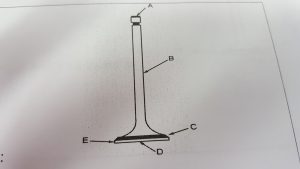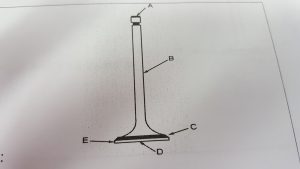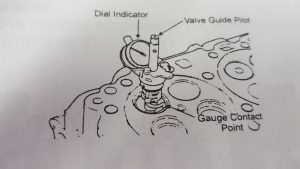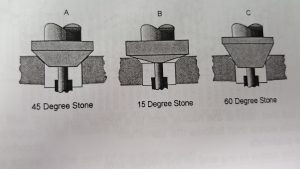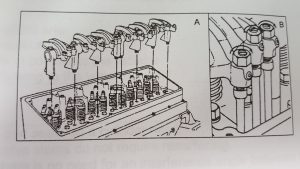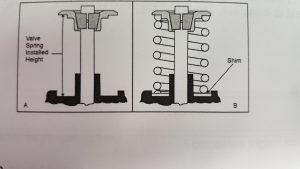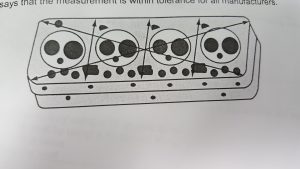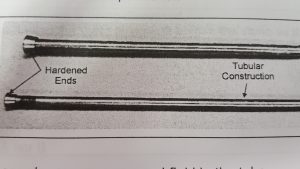Injector sleeves/tubes are usually made from:
Correct!
Wrong!
Valve crossheads (valve bridges) are used to:
Correct!
Wrong!
When grinding valves and seats, the one degree interference angle refers to the angle between the valve:
Correct!
Wrong!
Engine valve springs should be inspected for all of the following EXCEPT:
Correct!
Wrong!
What preparation must be done to the valve guides before measuring valve seat run out?
Correct!
Wrong!
When grinding valves and seats, if a valve lap mark is too close to the margin of the valve:
Correct!
Wrong!
When grinding valves and seats and restoring or replacing valve guides, the correct order of service is:
Correct!
Wrong!
Valve springs should be checked for:
Correct!
Wrong!
Valve guides are classified as:
Correct!
Wrong!
The margin of a valve refers to the:
Correct!
Wrong!
Hollow pushtubes that are found to have oil inside would be an indication that:
Correct!
Wrong!
Which instruments(s) should be used to measure wear in the valve guides?
Correct!
Wrong!
Why might it be necessary to remove valve seat inserts in order to surface grind a cylinder head?
Correct!
Wrong!
When glass beading valves, the head should be glass beaded but not the stem. The reason for this is:
Correct!
Wrong!
If a valve is not properly installed low enough into the head, what will NOT be a factor?
Correct!
Wrong!
Technician A says that the push-rods can be checked for straightness by rolling them on a known flat surface. Technician B says that if a push-rod is bent, but it cannot be seen by the eye, it will not cause a problem. Who is right?
Correct!
Wrong!
What is most likely to happen if a valve spring is not square?
Correct!
Wrong!
While inspecting the engine valves, what should the valve grooves be inspected for?
Correct!
Wrong!
While resurfacing the engine valves, what can indicate if the grinding stone needs to be dressed?
Correct!
Wrong!
Technician A says to measure the valve seat width accurately, the minimum tool requirement would be with a machinist''s scale. Technician B says to remove material according to the position of the valve face to valve seat width measurement. Who is right?
Correct!
Wrong!
In the figure below, what is the arrangement used to adjust the valve clearance?
Correct!
Wrong!
The term used to describe the opening of the intake valve before the exhaust valve has fully closed is known as:
Correct!
Wrong!
The function of coolant directors in the cylinder head is to:
Correct!
Wrong!
Technician A says the amount of material removed from the valve face is the size or thickness of the required valve spring shim. Technician B says shims are required to compensate for the increased valve stem tip height because of valve and seat resurfacing. Who is right?
Correct!
Wrong!
Valve seat inspection is being discussed on a large diesel engine. Technician A says if the valve seat is not within specification, the cylinder head must be replaced. Technician B says seat run out is a measure of how concentric the valve seat is in relation to the valve guide. Who is right?
Correct!
Wrong!
When measuring the cylinder head for warpage with a straightedge, the feeler gauge measurement is 0.025 in. (0.63 mm). The general rules for head reconditioning are: Technician A says that the cylinder head needs to be resurfaced. Technician B says that the measurement is within tolerance for all manufacturers. Who is right?
Correct!
Wrong!
Technician A says that a valve seat should be ground prior to changing a worn valve guide. Technician B says that valve guides should be inspected for wear, taper and out of round. Who is correct?
Correct!
Wrong!
Technician A says that valve rotators turn the valve to help remove deposits and help valve and seat wear uniformly. Technician B says that if the valve rotators seize and fail to rotate, the engine will quickly fail because of valve damage. Who is correct?
Correct!
Wrong!
When removing valve springs, it may be necessary to tap the retainer with a soft-faced hammer to:
Correct!
Wrong!
Cylinder head fasteners should be loosened from the:
Correct!
Wrong!
The dimension shown below illustrates what portion of a valve seal?
Correct!
Wrong!
A valve with excessive runout should be:
Correct!
Wrong!
Valve seat inserts can be removed by:
Correct!
Wrong!
Insufficient valve head height (below specifications) causes:
Correct!
Wrong!
Worn rocker arms, shafts and crossheads would most likely cause:
Correct!
Wrong!
Valve springs that measure greater than 1/16 in. (1.6 mm) out of square should be:
Correct!
Wrong!
As the installed height of a valve spring increases, the valve spring tension:
Correct!
Wrong!
Crossheads must be carefully adjusted to ensure that:
Correct!
Wrong!
The purpose of the coolant and oil passages in the cylinder head is to:
Correct!
Wrong!
The purpose of a carbon scraper on a valve is to prevent carbon buildup:
Correct!
Wrong!
A valve spring seat is used to:
Correct!
Wrong!
When compared to an integral valve seat, valve seat inserts provide a replaceable wear surface with improved:
Correct!
Wrong!
Which of the following statements is true about cylinder head retaining studs?
Correct!
Wrong!
Pushrods are commonly found as being tubular in construction. Tubular rods are used because:
Correct!
Wrong!
When adjusting valve clearances, Technician A says that feeler gauge should slide with slight resistance. Technician B says that on some applications, the intake valve clearance is less than the clearance for the exhaust valve. Who is right?
Correct!
Wrong!
Heads, Valves, and Components
You Failed!
You Passed!
Share your Results:

